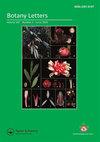Improving seed germination of native species for camel rangeland restoration: effects of cold stratification and temperature
IF 1.3
4区 生物学
Q3 PLANT SCIENCES
引用次数: 0
Abstract
ABSTRACT Native plants of the Sahara are remarkably resistant to prolonged droughts and are important sources of forage, food, and medicine. Their regeneration from seeds after strong anthropogenic disturbances is a challenging step toward their conservation and to mitigate desertification. We studied the germination responses of 43 dominant native species of the Sahara desert that could be propagated from seeds for future ecological restoration projects, exploring the effects of cold stratification and temperatures on seed germination. Seeds were stratified at 4°C for 3 days and then tested for germination at 5, 10, 15, 20, 25, 30, 35, and 40°C. While cold stratification negatively affected four species, it improved the germination of 36 species. Five of these species required cold stratification to germinate. Temperatures during the germination trial significantly influenced seed germinability. Twenty-three species (54%) germinated to higher percentages at intermediate temperatures (20 to 30°C) similar to the maximum temperatures of the rainiest months, when germination in the field is high. Thirteen species (30%) also germinated at a higher temperature (40°C). Seven species (16%) germinated best at low temperatures (5 to 10°C). Our results suggest that cold stratification is an efficient and easy treatment to apply prior to sowing seeds in the field for restoration.冷分层和温度对改善骆驼牧场恢复用本地物种种子发芽的影响
撒哈拉的本土植物对长期干旱具有显著的抵抗力,是重要的饲料、食物和药品来源。在强烈的人为干扰后,它们从种子中再生是保护和缓解荒漠化的一个具有挑战性的步骤。我们研究了撒哈拉沙漠43种优势本土物种的发芽反应,这些物种可以通过种子繁殖,用于未来的生态恢复项目,探索了寒冷分层和温度对种子发芽的影响。种子在4°C下分层3 天,然后在5、10、15、20、25、30、35和40°C下测试发芽情况。低温层积对4个种的发芽有负面影响,但对36个种的萌发有促进作用。其中五个物种需要低温分层才能发芽。发芽试验期间的温度显著影响种子的发芽性。23个物种(54%)在中等温度(20至30°C)下发芽率更高,与降雨量最大的月份的最高温度相似,此时田间发芽率很高。13个物种(30%)也在更高的温度(40°C)下发芽。7种(16%)在低温(5至10°C)下发芽最好。我们的研究结果表明,在田间播种进行恢复之前,冷分层是一种有效且容易的处理方法。
本文章由计算机程序翻译,如有差异,请以英文原文为准。
求助全文
约1分钟内获得全文
求助全文
来源期刊

Botany Letters
Agricultural and Biological Sciences-Plant Science
CiteScore
3.10
自引率
6.70%
发文量
54
期刊介绍:
Botany Letters is an international scientific journal, published by the French Botanical Society (Société botanique de France) in partnership with Taylor & Francis. Botany Letters replaces Acta Botanica Gallica, which was created in 1993, building on over a century of renowned publications by the Société botanique de France.
 求助内容:
求助内容: 应助结果提醒方式:
应助结果提醒方式:


